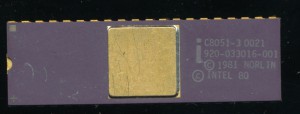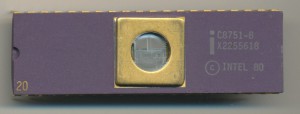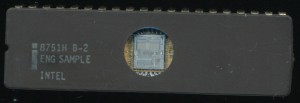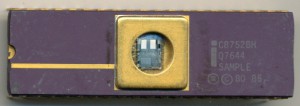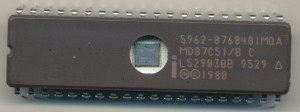The Evolution of the Intel 8051 Processes
That’s not a typo, we’re going to look briefly at the technology processes (rather then the processors themselves) Intel went through in the first 5 years of the MCS-51 microcontrollers, and the exceedingly confusing nature of the resulting naming. When the Intel 8051 series was released in 1980 it was made on two different processes. The 8031/8051 (non-EPROM) were made on the HMOS-I process, a 3.5 micron single poly process.
The EPROM version, the 8751 was made on an EPROM process, HMOS-E, which was still a 3.5 micron process, but with 2 poly layers. This resulted in some slight differences in electrical characteristics (not to mention the programming features not needed on the MaskROM and ROMless versions.
Intel then moved to the HMOS-II (Intel Process P414.1) process in 1984. This was a shrink to 2 microns, and the EPROM version was also shrunk, but again, using a slightly different EPROM process (Intel Process P421.X). The HMOSII MaskROM and ROMless versions received the suffix AH, ‘A’ denoting a minor update to the architecture, and ‘H’ for the new HMOSII process. The EPROM version did not see the same updates though, it received EPROM security bit support and was simply called the 8751H.
At this time Intel was also developing CMOS versions of the MCS-51 series. This would be denoted with the familiar ‘C’ in the part number and use the 1.5 micron CHMOS-III-E process. This was the first time that Intel used the same process for both the EPROM, and non-EPROM versions, though its possible early versions did not. The MCS-51 was again updated with additional features (mainly power down states taking advantage of CMOS) to be worthy of a ‘B’ modifier as well resulting in part numbers with the suffix of BH such as the 87C51BH P80C31BH etc.
Intel had not forgot the original HMOS versions, in 1987 the 8751H was upgraded to a 1.5 micron HMOS-III-E process (Intel Process P422) resulting in the 8751BH. The non-EPROM ‘AH’ versions did not receive the process upgrade. This left Intel with 3 distinct process version of the MCS-51. One for the HMOS non-EPROM, one for the HMOS EPROM, and one for the CHMOS versions.
Thankfully Intel began to stop changing part numbers every time there was process change. There was two reasons for this. One, it wasn’t very user-friendly, and very hard to keep up with with multiple fabs making parts on different processes. More importantly, they got to a point technologically where they no longer needed to. The parts could now were engineered at each process node to fully meet the datasheet specifications, without having to completely modify the specs listed. For all intents and purposes, a microcontroller should be process independent as much as possible. If the system is designed well, and the part meets spec, it will not matter (to a point) what process it was built in. Of course, if the system was designed using a non-documented feature, for example a higher drive strength then spec) then a different process part may cause issues, but that is where good engineering design wins.
By 1996 EPROM CMOS 87C51s were simply ’87C51’and HMOS ones were 8751 (with various suffixes for speed). MaskROM and ROMless versions were 8031AH/8051AH for HMOS, and 80C31BH/80C51BH for CMOS. Newer parts, such as the 80C32/52 dropped the suffix all together. This allowed the suffix to be used solely to denote extra features or speeds, instead of trying to track processes.


